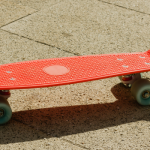Mastering the art of performing an ollie on a skateboard can be quite challenging, especially for beginners.
It requires the right balance, foot positioning, and timing to successfully execute this fundamental trick.
Many factors can contribute to your difficulty in performing an ollie, such as lack of proper technique, fear of falling, or simply not being familiar with the skateboard’s dynamics.
In this article, we will explore these challenges in detail and provide useful tips to help you conquer the ollie.
Understanding the Ollie:
The ollie is a fundamental skateboarding trick that involves lifting both the skateboard and the rider into the air without the use of hands. It consists of three primary components: the pop, the slide, and the leveling out.
Foot Placement:
Achieving the perfect ollie starts with the foundation — foot placement. Your front foot should be angled at approximately 45 degrees and placed near the middle of the skateboard. Simultaneously, your back foot should find its home on the tail, with the ball of your foot near the edge for optimal control.
This stance not only provides stability but also sets the stage for the dynamic movements that follow.
The Pop:
The pop is the initial burst of energy that sends your skateboard soaring into the air. To achieve this, engage your back foot by firmly pressing down on the tail. This action causes the board’s nose to rise, creating the necessary lift. Simultaneously, shift your weight towards the tail, leveraging your body to generate the required force.
Mastering the pop is crucial, as it sets the tone for the entire ollie and dictates the height you can achieve.
The Slide:
As the tail rises, seamlessly slide your front foot towards the skateboard’s nose. This motion is not a mere shuffle but a swift, controlled drag along the grip tape. The purpose of this sliding action is to level out the board, ensuring a stable and controlled ascent into the air.
Precision is key during the slide; practice the motion until it becomes second nature, as it directly influences the success of your ollie.
Leveling Out:
With your front foot reaching the peak of its slide, it’s time to level out the skateboard. Align the board parallel to the ground by leveling your feet. This adjustment is essential for a smooth descent and a controlled landing.
Mastery of the leveling out phase distinguishes a stylish ollie from a haphazard one. Practice this step until achieving a seamless and leveled finish becomes instinctive.
Common Mistakes and How to Overcome Them in Mastering the Ollie:
So, why can’t you ollie on a skateboard? The answer may differ from person to person. It could be due to incorrect foot placement, lack of balance or timing, or not committing fully to the trick.
Whatever the reason may be, here are some common mistakes and tips for overcoming them:
Insufficient Pop:
Issue: Weak pop results in a feeble ollie.
Solution: To address this, prioritize practicing the pop—the force that initiates the board’s ascent. Focus on forcefully pressing down on the tail with your back foot, emphasizing a quick and powerful motion. The key is to generate upward momentum, so dedicate time to perfecting the strength and speed of your pop.
Inconsistent Slide:
Issue: Uneven or hesitant sliding impedes board control.
Solution: The sliding motion is crucial for leveling out the board during the ollie. Combat inconsistency by drilling this movement repeatedly. Emphasize a fluid and swift slide of your front foot along the grip tape. Practicing this component consistently will enhance control and ensure a smoother execution of the trick.
Uneven Weight Distribution:
Issue: Incorrect weight placement disrupts balance.
Solution: Achieving the right balance between your front and back foot is vital for a successful ollie. During the pop, concentrate on shifting your weight smoothly from the back foot to the front foot as you initiate the slide. This seamless transition ensures stability, allowing you to control the board’s movement throughout the trick.
Fear of Commitment:
Issue: Hesitation can hinder progress.
Solution: Overcoming the fear of commitment is a psychological aspect of mastering the ollie. Start by practicing on a flat, smooth surface where the risk of falling is minimized. Focus on building confidence in executing the pop, slide, and leveling out. As you gain proficiency and assurance, gradually progress to more challenging terrains. Visualization and positive reinforcement can also help overcome the fear associated with committing to the ollie.
Conclusion:
Mastering the ollie is a rite of passage for every skateboarder.
By understanding the intricacies of foot placement, pop, slide, and leveling out, you can systematically overcome the challenges preventing you from executing this fundamental trick.
Patience, persistence, and practice are key components of the learning process, so don’t be discouraged if progress seems slow.
Embrace the journey, celebrate small victories, and soon you’ll find yourself soaring through the air with a perfectly executed ollie.
![Why do skateboarders hate scooters? [Reasons + Tips] Why do skateboarders hate scooters? [Reasons + Tips]](https://bedoper.site/wp-content/uploads/2023/04/Why-do-skateboarders-hate-scooters-150x150.png)


![How fast do skateboards go downhill? [90 mph (145 km/h)] How fast do skateboards go downhill? [90 mph (145 km/h)]](https://bedoper.site/wp-content/uploads/2023/04/How-fast-do-skateboards-go-downhill-150x150.png)
